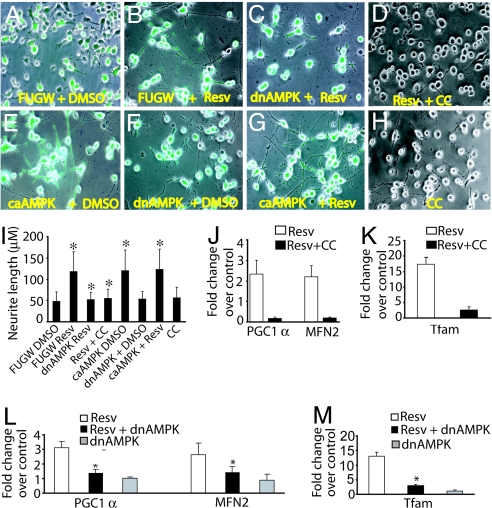Fig. 3.
Resveratrol-induced neurite outgrowth and mitochondrial biogenesis are dependent on AMPK. Neuro2a cells were infected with lentivirus expressing GFP only (FUGW, control), dnAMPK, or caAMPK. Three days later, cells were shifted to serum-starvation medium (0.2% FCS) containing DMSO (control) or 10 μM resveratrol (Resv). In addition, uninfected Neuro2a cells in serum-starvation medium were treated with resveratrol alone, 10 μM AMPK inhibitor CC alone, or with resveratrol and CC together. Images of the cultures captured in bright-field and green fluorescence were overlaid to visualize neurite outgrowth. Resveratrol-treated cells demonstrated robust neurite outgrowth (B) that was blocked by inhibition of AMPK by dnAMPK (C) or CC (D). Conversely, cells infected with caAMPK demonstrated increased neurite outgrowth in the absence of resveratrol (compare E with A). dnAMPK alone (F) or CC alone (H) did not inhibit neurite outgrowth by themselves. (G) Neurite length in cells treated with caAMPK + resveratrol. (I) Quantitative analysis of average neurite length showed significant (denoted by asterisks) neurite outgrowth inhibition by AMPK inhibition (P < 0.001) and neurite outgrowth promotion by caAMPK (P < 0.005). (J and K) Quantitative RT-PCR analysis of markers of mitochondrial biogenesis demonstrated that resveratrol treatment resulted in an 18-fold increase in Tfam (K) and 2-fold increases in PGC-1α and mitofusin 2 (MFN2) mRNA levels (J), which were inhibited by CC. (L and M) Similar results were observed by genetic inhibition of AMPK with dnAMPK. Values were normalized to the 18S transcript. Data shown are representative of two independent experiments.

